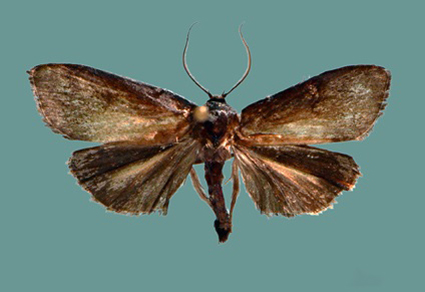Abstract
A novel endemic pest of clove tree, Cryptophasa warouwi sp. nov., has been discovered on Sangihe Island. This new species can be distinguished from its closest relative species, C. watungi Sutrisno & Suwito, 2015 which is found in North Sulawesi, by its dark brown straw-coloured wings in both males and females. The most distinctive diagnostic characters of this new species are observed in its genitalia structure: a bent-downward uncus with a strongly sclerotized finger-shaped apex, a bent phallus gradually widened towards coecum, and a double, membranous corpus bursae branching off at mid-ductus corpus bursae of female genitalia. Additionally, DNA barcodes revealed this new species to be embedded among Australian Cryptophasa species despite having fasciculated male antennae that have been considered diagnostic of the genus Paralecta. This suggests that the male antennae may not be a reliable character for separating Cryptophasa from Paralecta. A more comprehensive study including all Cryptophasa and Paralecta will be required to elucidate the definition of each genus. Images depicting both adults and genitalia are provided for this newly recognized species.
References
- Diakonoff, A.N. (1948) Microlepidoptera of the Wissel Lakes, West New Guinea II. Treubia, 19 (2), 183–195.
- Diakonoff, A.N. (1954) Microlepidoptera of New Guinea, Results of the Third Archbold Expedition (American-Netherlands Indian Expedition 1938–1939). Part IV. Koninklijke Nederlandse Akademie van Wetenschappen te Amsterdam, 2 (Afdeling Natuurkunde, dl. 50, No. 1), 3–191. https://doi.org/10.5962/bhl.title.120166
- Diakonoff, A.N. (1966) Records and descriptions of South Asiatic Microlepidoptera. Tijdschrift voor Entomologie, 109 (3), 49–88, pl. 1
- Duponchel, P.A.J. (1844) n.k. In: d’Orbigny, C. (Ed.), Dictionnaire universel d’Histoire Naturelle, résumant et complétant tous les faits présentés par les encyclopédies, les anciens dictionnaires scientifiques, les oevres complètes de Buffon, et les traités spéciaux sur les diverses branches des êtres et des divers phénomènes de la nature. Vol. 4. Renard, Martinet u. Co., Paris, pp. 1–752. https://doi.org/10.5962/bhl.title.34824
- Edgar, R.C. (2004) MUSCLE: multiple sequence alignment with high accuracy and high throughput. Nucleic Acids Research, 32 (5), 1792–1797.
- https://doi.org/10.1093/nar/gkh340
- Hebert, P.D.N., deWaard, J.R., Zakharov, E.V., Prosser, S.W.J., Sones, J.E., McKeown, J.T.A., Mantle, B. & La Salle, J. (2013) A DNA ‘Barcode Blitz’: Rapid Digitization and Sequencing of a Natural History Collection. PLoS ONE, 8 (7), e68535. https://doi.org/10.1371/journal.pone.0068535
- Holloway, J.D., Kibby, G. & Peggie, D. (2001) The families of Malaysian moths and butterflies. Brill, Leiden, 455 pp.
- Lewin, J.W. (1805) Prodromus Entomology. Natural History of Lepidopterous Insects of New South Wales. T. Bensley, London, 19 pp., 18 pls., text.
- Common, I.F.B. (1990) Moths of Australia. Melbourne University Press, Melbourne, 535 pp. https://doi.org/10.1071/9780643101227
- McMillan, I.C. (2019) Redescription of Cryptophasa irrorata Lewin, 1805 (Lepidoptera: Gelechioidea: Xyloryctidae). Zootaxa, 4615 (1), 192–200. https://doi.org/10.11646/zootaxa.4615.1.12
- McMillan, I.C. (2013) Xyloryctine moths of Australia. Genera and Species. Available from: http://Xyloryctinemothsofaustralia.blogspot.com (accessed 13 December 2023)
- Meyrick, E. (1910) Descriptions of Malayan Micro-Lepidoptera. Transactions Entomological Society of London, 1910, 430–478. https://doi.org/10.1111/j.1365-2311.1910.tb01179.x
- Meyrick, E. (1917) n.k. In: Exotic Microlepidoptera. 2 (2–3). Taylor and Francis, London, pp. 33–64 + 65–96.
- Meyrick, E. (1925) n.k. In: Exotic Microlepidoptera. 3 (5–7). Taylor and Francis, London, pp. 129‒160 + 161‒192 + 193‒224.
- Meyrick, E. (1925) Exotic Microlepidoptera. 3 (14–15). Taylor and Francis, London, 433 pp.
- Meyrick, E. (1930) Exotic Microlepidoptera. 4 (1). Taylor and Francis, London, 32 pp.
- Meyrick, E. (1938) Papuan Microlepidoptera Transactions of the Royal Entomological Society of London, 87, 503–529. https://doi.org/10.1111/j.1365-2311.1938.tb00727.x
- Rante, C.R. & Watung, J.F. (2016) Pest of branch borer (Lepidoptera: Xyloryctidae) on Clove tree in Sangihe Islands Regency, North Sulawesi Province. Entomological Society of Indonesia National Symposium Proceeding, Palu, 2016, 88–96
- Robinson, G.S. (1976) The preparation of slide of Lepidoptera genitalia with special references to the microlepidoptera. Entomologist’s Gazette, 27, 127–132.
- Robinson, G.S., Tuck, K.R. & Shaffer, M. (1994) A Field Guide to the Smaller Moths of South-East Asia. Natural History Museum, London, 308 pp. [61].
- Saitou, N. & Nei, M. (1987) The neighbor-joining method: a new method for reconstructing phylogenetic trees. Molecular Biology and Evolution, 4 (4), 406–425.
- Snellen, P.C.T. (1878) Nieuwe exotische Tineinen van ‘S Rijks Museum van Natuurlijke Historie te Leiden. Tijdschrift voor Entomologie, 21, 129–147, pls. 7–8
- Sutrisno, H., Watung, J.F. & Suwito, A. (2015) Discovery of Cryptophasa Lewin, 1805 (Lepidoptera: Xyloryctidae) from Indonesia with the descriptions of three new species. Zootaxa, 3994 (1), 122–132. https://doi.org/10.11646/zootaxa.3994.1.6
- Tamura, K., Stecher, G. & Kumar, S. (2021) MEGA11: molecular evolutionary genetics analysis version 11. Molecular Biology and Evolution, 38 (7), 3022–3027. https://doi.org/10.1093/molbev/msab120


